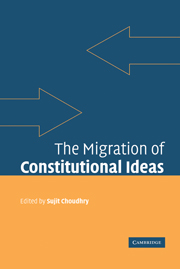Book contents
- Frontmatter
- Contents
- List of contributors
- Acknowledgements
- 1 Migration as a new metaphor in comparative constitutional law
- PART I The methodology of comparativism
- 2 On the blurred methodological matrix of comparative constitutional law
- 3 Some reflections on method in comparative constitutional law
- 4 The postwar paradigm and American exceptionalism
- PART II Convergence toward a liberal democratic model?
- PART III Comparative constitutional law, international law and transnational governance
- PART IV Comparative constitutional law in action – constitutionalism post 9/11
- Index
3 - Some reflections on method in comparative constitutional law
Published online by Cambridge University Press: 25 July 2009
- Frontmatter
- Contents
- List of contributors
- Acknowledgements
- 1 Migration as a new metaphor in comparative constitutional law
- PART I The methodology of comparativism
- 2 On the blurred methodological matrix of comparative constitutional law
- 3 Some reflections on method in comparative constitutional law
- 4 The postwar paradigm and American exceptionalism
- PART II Convergence toward a liberal democratic model?
- PART III Comparative constitutional law, international law and transnational governance
- PART IV Comparative constitutional law in action – constitutionalism post 9/11
- Index
Summary
Why study comparative constitutional law? For a scholar, of course, the value seems obvious: more knowledge is generally better than less. Others have a more instrumental interest. They might want to know whether studying comparative constitutional law might improve our ability to make domestic constitutional law. Responding to that inquiry requires some examination of how we can actually do comparative constitutional law.
I confine my attention to questions implicated in doing comparative constitutional law as law. There is of course a large field of comparative studies of governmental organization, conducted by political scientists as well as by lawyers, and some of that field overlaps with the field of comparative constitutional law. But, there is also one large difference between the fields. Comparative constitutional law involves doing law. And, as I have learned, it is quite difficult to be comfortable in doing law in more than one legal system. Even when language barriers do not intervene, legal cultures do. For example, I have been persuaded – despite my initial scepticism – that Australian constitutional culture is far more formalist than US constitutional culture. It is less open to what seem to me the inevitable intellectual challenges from those influenced by US legal realism and its legacy. As a result, constitutional doctrines in Australia, such as those dealing with the allocation of authority between the national and the state governments, are more stable than similar doctrines in the United States, even doctrines framed in language that seems parallel to that used in the Australian cases.
- Type
- Chapter
- Information
- The Migration of Constitutional Ideas , pp. 67 - 83Publisher: Cambridge University PressPrint publication year: 2007
- 3
- Cited by



